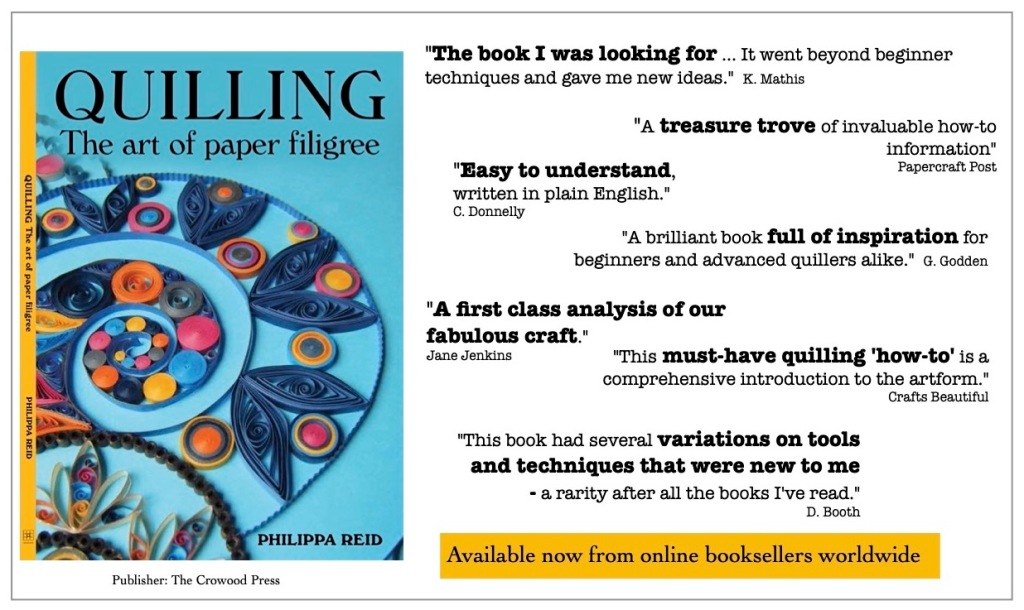


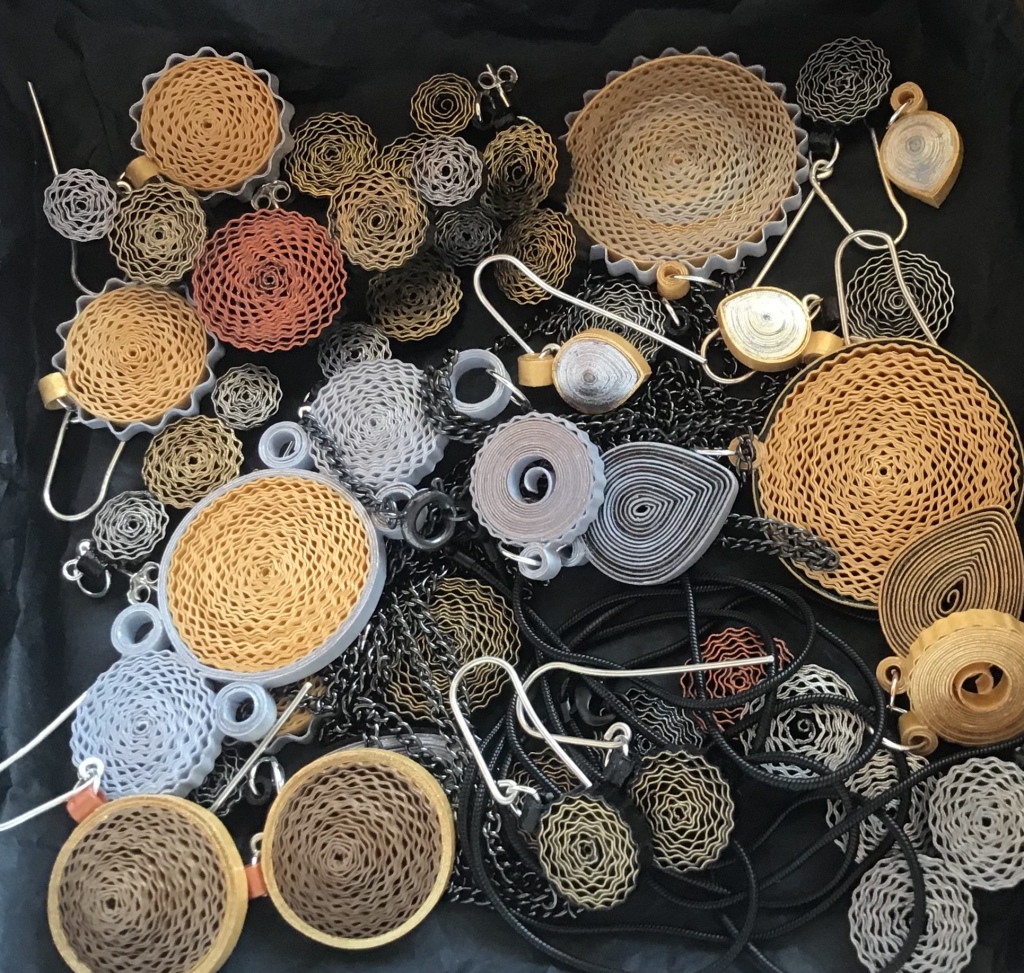
From a maker’s point of view, the very best thing about paper quilled jewellery must surely be its creative versatility. As is always the case with quilling, the range of possible techniques that can be utilised is an inspiration in itself – a point that is stressed throughout my book, and which I make no apology for repeating here.
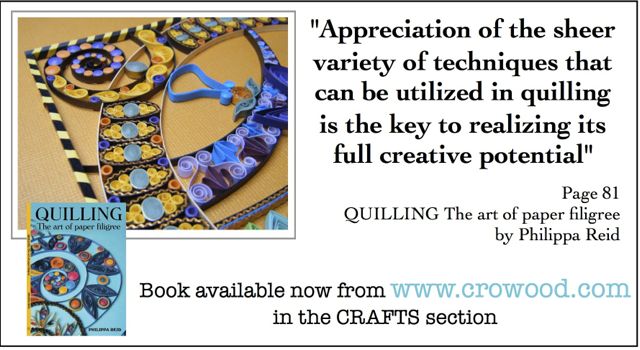
This versatility extends to colour and finish, too, since quilling strips are available in such an amazing range of different shades. Some – which I particularly like to utilise – are even edged with special applications that give the appearance of precious metals.
People often express concern that beads and charms made from paper may lack longevity and dissolve in the rain – but their fears are completely unfounded! I treat all my jewellery pieces with a special non-toxic glue/varnish which makes them hard, strong and water resistant.
To prove the point, I once experimented by holding a varnished paper bead underneath a running tap for several minutes:
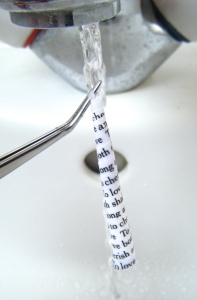
After being dried out in an airing cupboard overnight, the bead re-hardened and was good as new!
We are probably all familiar with paper mâché, in which shredded paper is mixed with flour and water, moulded into the required shape and left to dry. The dried-out mixture is rock hard … and exactly the same applies to quilled pieces after the glue/varnish has set. I always liken the end result to the consistency of balsa wood – surprisingly strong, yet amazingly light in weight.
Which brings us to the third great thing about paper quilled jewellery – it’s really light to wear. For people who like big dangly earrings, but hate the feeling of their ear lobes being weighted down, quilled earrings are an absolute joy!

Recently, I started making my own earring wires out of Sterling Silver, and I’ve been pleasantly surprised by how comfortable they are. The ends are filed so that they pass smoothly through pierced ears, and the long-drop design actually complements the quilling by making a feature of the wire itself. These earrings are big enough to make a bold fashion statement, yet they really are so light that it’s easy to forget you are wearing them at all!
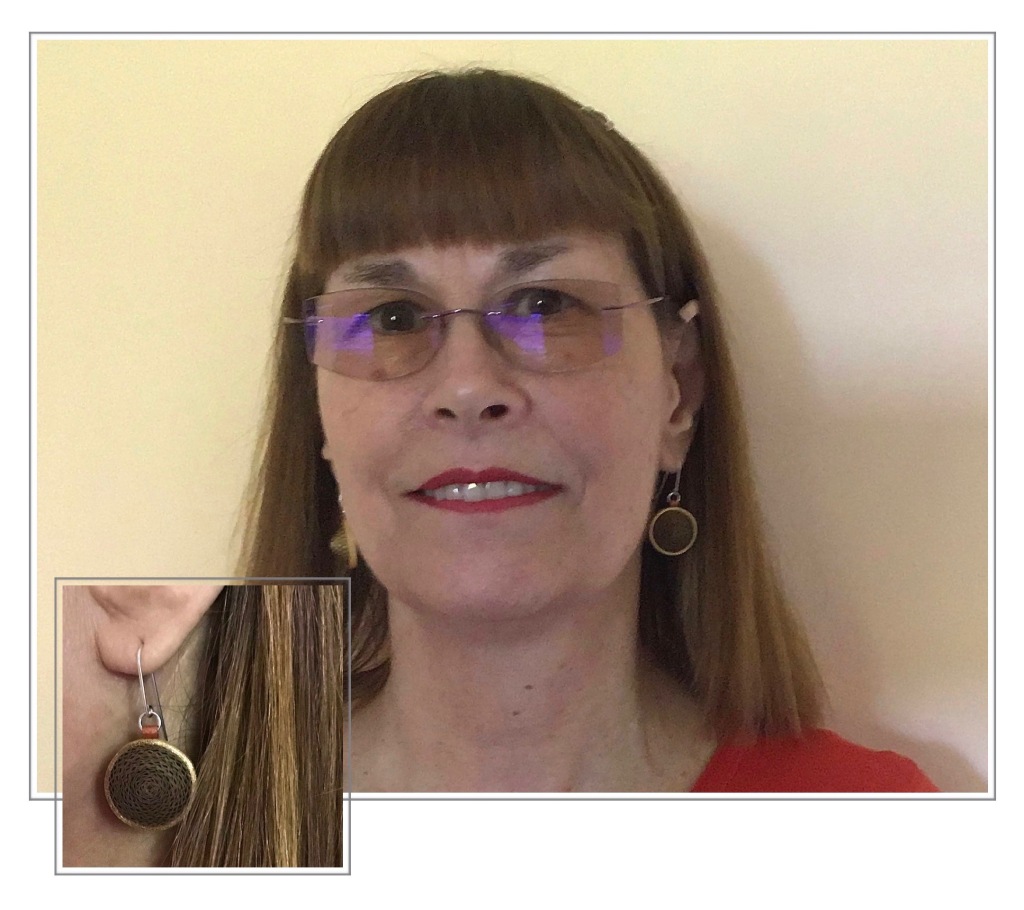
A lot of thought goes into designing quilled paper jewellery, so it’s only right that careful consideration should be given to the choice of metal fittings too.
Sterling Silver is a must, not only in terms of its bright lustrous appearance, but also its suitability for wear by people who suffer with allergies. I now regard cheaper, silver plated fittings as very inferior substitutes.
When it comes to necklaces, I have fallen totally in love with snake chains, whose smooth sinusoidal curves look wonderful with quilled pendants and charms. Colourful quilling can also be offset beautifully by black/oxidised chains. When selecting fittings, it definitely pays to be creative!

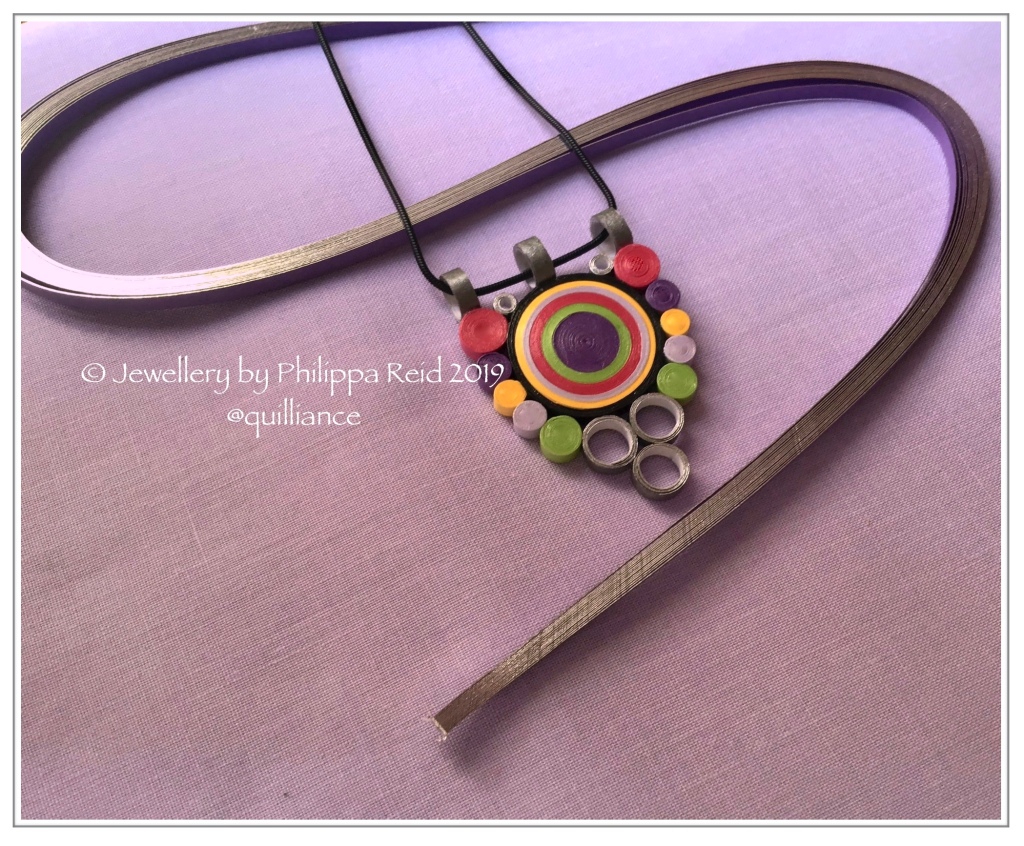
One final thing … if you are thinking about purchasing jewellery as a gift, what better way to celebrate a first wedding anniversary which is, after all, associated with the material paper? If the paper has the appearance of silver or gold, so much the better!
All photos and designs copyright Philippa Reid.
“A quiller’s dream“
“Beautifully written“
“A wonderful resource for both new and experienced quillers”
“Jam-packed full of up to date, important and useful information“
“A first class analysis of our fabulous craft“
Until recently, the only online ‘voice’ talking about my new book ‘QUILLING The art of paper filigree’ has been my own …but now, just days after publication in the UK (soon to be followed by scheduled release dates across the world), feedback is starting to reach me from a chorus of different people who have seen it for the very first time.
The quotations shown above are some of the initial comments that have come my way online, and truly they are music to my ears. Such comments suggest that I may, after all, have succeeded in my quest to produce a thoroughly practical book that both informs and inspires, demonstrating the amazing creative potential of all the different quilling techniques in their almost infinite variety.
Today, another voice has been added to the chorus. I’m delighted to say that Ann Martin has featured the book on her wonderfully informative All Things Paper blog, offering readers the chance to win a free copy in an international giveaway, by kind courtesy of the publishers The Crowood Press!
Ann’s post gives a very detailed insight into what’s inside the book, including selected page images and some of my own commentary.
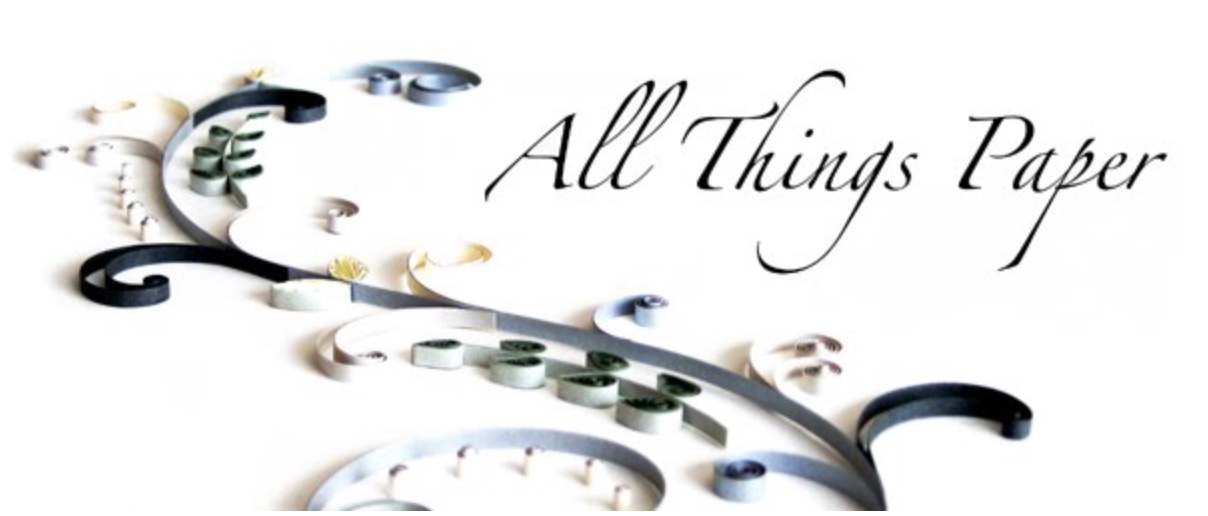
Of course, if you just can’t wait to see how you fare in the giveaway, you can purchase a paperback or electronic copy of the book direct from the publishers right here via this link.
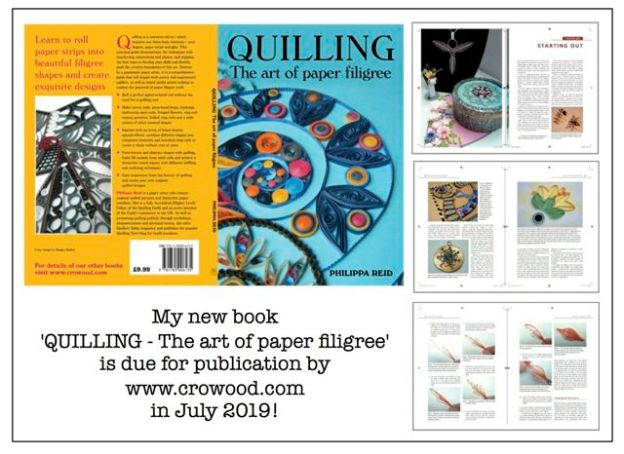
It’s happening at last! The first advance copies of my book ‘QUILLING – the art of paper filigree‘ – arrived in the UK yesterday, and my publishers, Crowood Press, have already created a page for it on their website for pre-orders. If you’d like to reserve a copy for delivery as soon as it is published, you can access the direct link here.
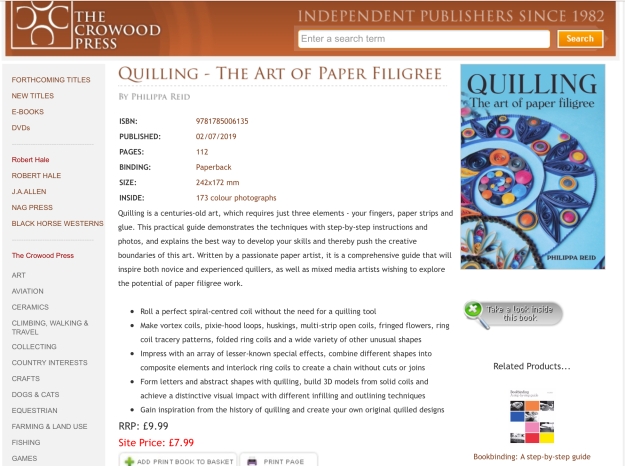
Publication is scheduled for July 2019, as we wait for the bulk shipment of books to arrive by sea. Meanwhile, however, I am finally free to reveal the cover artwork, along with the detailed back-page overview of what the book contains.
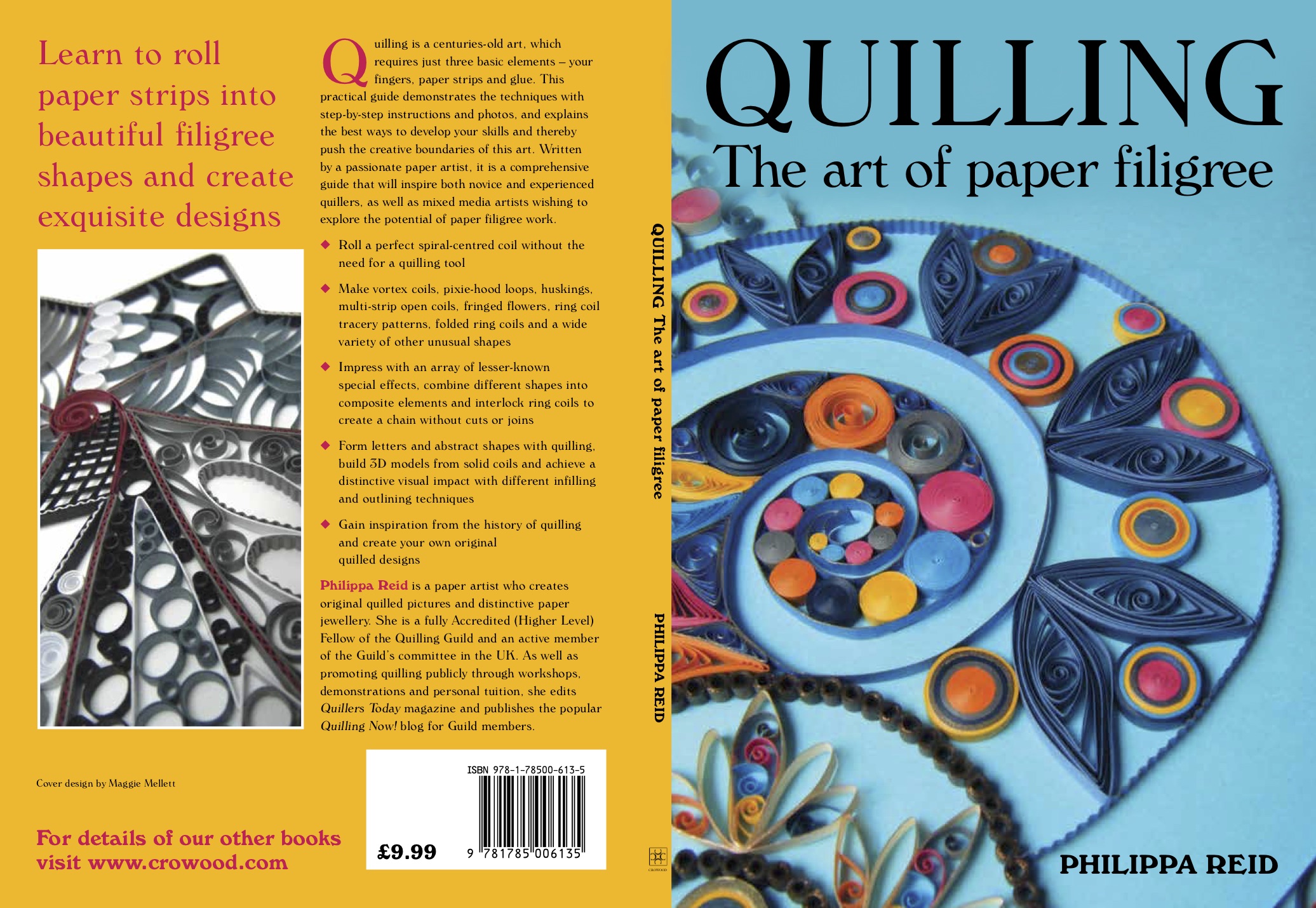
As I explained in my last post, this is a quilling book with a difference. Unlike other project-based books that currently proliferate in the crafting market, my book is intended to be a comprehensive ‘how-to’ guide that aims to describe every aspect of quilling in all its inspirational variety. It deals with hands-on practicalities in a very detailed way, seeking to encourage readers’ own innate creativity through the mastery of technique. In short, it’s designed to inspire!
I am proud of the cover artwork, which was a project I worked on during my artist’s residency at Taunton’s wonderful CICCIC gallery last year.
Here’s the finished framed piece which was designed to sum up the scope of the book, using a broad mix of techniques to illustrate the vast range of different visual effects that can be achieved in the context of colourful circles and spirals. Unconventional, maybe – but a genuine expression of my own creative heart.
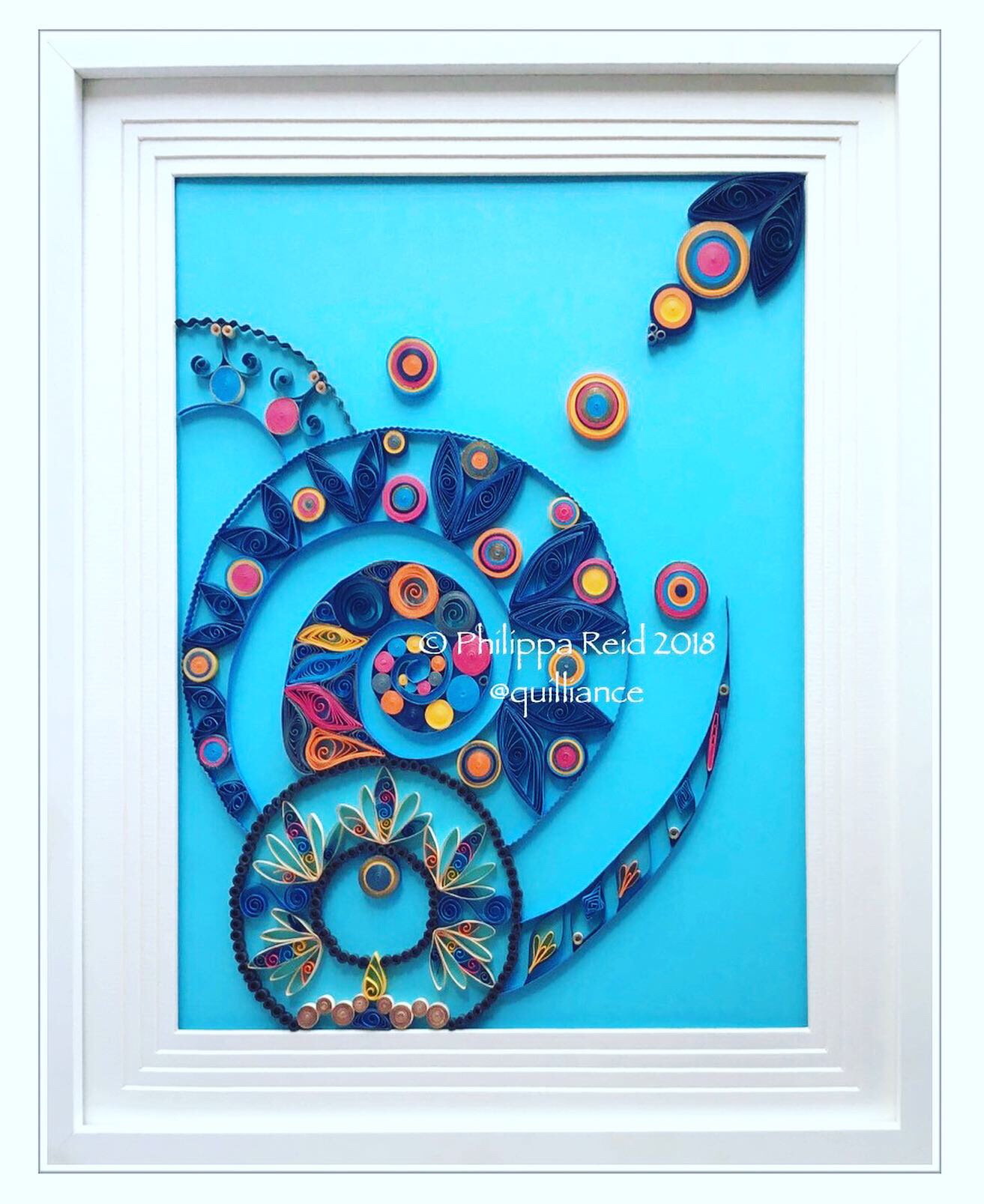
All that remains is for me to commend this book to you, and trust that it will be received in the same open-minded creative spirit as that in which it was written.
Let me leave you with a few quotes from the text:
“Appreciation of the sheer variety of techniques that can be utilised in quilling is the key to realising its full creative potential.“
“There is a wealth of creative potential to be found beyond the realm of the closed loose coil.“
“The intricacy of a quilled design can be both impressive and daunting in equal measure. However, when broken down into its constituent parts, a quilling usually reveals itself as much less complex than appearances may suggest.“
If any or all of these sentiments ring true in your mind, maybe this is the book you have been waiting for…
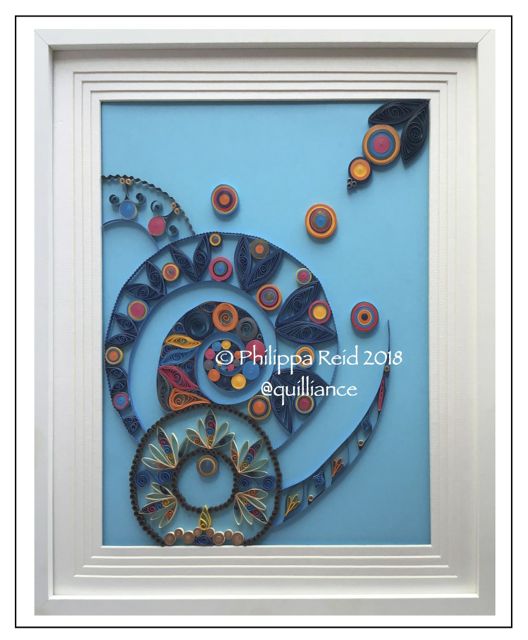
The final proofs have been checked and signed off … and now my book – ‘QUILLING – THE ART OF PAPER FILIGREE’ – is going off to print, ready for worldwide publication in July 2019!
This photo shows the quilled piece which I created especially for the photograph on the front cover.
Apart from a brief outing at the Quilling Guild‘s Celebration Weekend last year, I’ve been keeping it largely ‘under wraps’ until now.
The time has now come, I feel, to tell the whole story of how the idea of the book first came into being.
It had never been my intention to write a book, as I am always kept busy in my role as Editor of Quillers Today magazine for Guild members, in addition to my own quilled projects. Out of the blue, however, I was contacted by the Commissioning Editor of the UK-based Crowood Press at the end of February last year, stating that they wanted to commission a practical book on quilling – and would I be interested in writing it for them?
At first, I hesitated. The requirement for 25,000 – 30,000 words and 150+ photos sounded like an awful lot of work on top of all my other commitments! As an experienced freelance writer, however – (my past career for many years) – I knew that I could do it … but I felt equally clear about the the only type of book I’d be prepared to write.
My book would have to be different from all the other project-based books that currently proliferate in the crafting market. It would be a comprehensive ‘how-to’ guide presenting every aspect of quilling in all its inspirational variety. It would deal with hands-on practicalities in a very detailed way, seeking to encourage readers’ own innate creativity through the mastery of technique.
I shared this viewpoint with the Editor, who replied reassuringly that “it seems we both want to publish the same book”!
I was hooked. I brainstormed a synopsis for the work over the course of a weekend, and from that point on – once contracts had been signed – the book literally powered its way out of my head like an express train!!
It took me nine months in total, with several weeks’ break during the Summer which were taken up fulfilling various arts festival and other commitments.
The writing was completed just before Christmas 2018. I was told that the manuscript would be passed to a Copy Editor who might suggest changes or raise queries if anything didn’t make sense. There were none! My copy and photographs were passed straight through to the typesetter without any requests for alterations. When the layout came back to me for proof-reading, the corrections needed were minimal. Such a smooth passage through the production process has boosted my confidence no end! Now the files are being passed to an overseas printer, and I must wait patiently for delivery of the printed books which will eventually arrive in the UK by container ship, in time for publication in July.
Once published, it will be available to order (internationally) through the publisher’s website, as well as being sold through bookshops. I will share more information about this just as soon as I am able.
Meanwhile, patience (tempered by a degree of trepidation!) is the order of the day.
I can honestly say that I have enjoyed every minute of the process. This book means more to me than all the brochures, newsletters and PR features I wrote throughout a lengthy freelance career in marketing, most of which now lie forgotten in a box, unlooked at and unloved. Quilling has undoubtedly become my life in recent years … and this book will surely be my legacy.


It was never my intention to become a jewellery designer. However, fate (with a great deal of assistance from arts festival collaborators in Taunton) has conspired to introduce me into a wonderful new world of jump rings, round and flat-nosed pliers, earring posts and snake chains!
This journey began with my conical bead jewellery – created mainly from upcycled magazine pages and marbled paper offcuts – which have proved consistently popular over the years, and to which I have now dedicated a separate page here on my blog entitled ‘My Jewellery‘.
However, with help and encouragement from colleagues at the Polkadot Jewellery Gallery in Taunton – where my quilled paper and Sterling Silver jewellery is now stocked – I am developing a whole new collection of pieces which utilise crimped, metallic-edged quilling strips, alongside some selected conical bead pieces. It’s proving to be a really exciting process, creatively challenging yet at the same time very fulfilling too.
My sales in the run-up to Christmas have been very encouraging, surpassing even my wildest expectations!
As the process continues, I am gradually moving away from any pre-conceived ideas that I had about jewellery. My mind is being opened to new design concepts and the merits of different chain lengths, styles and other metallic fittings which I now realise play such an important role in complementing the quilling itself.
It is, indeed, a chain reaction! One thing leads to another, and whilst today I am so thrilled to have recently discovered the beauty of smooth-sided snake chains (like the one in the picture at the top of this post), who knows what the future will hold?
I am often asked whether I sell my jewellery pieces online, and the answer is that – for the moment at least – I prefer to operate solely as a retail supplier, as I am doing with Polkadot. Having said that, however, I am willing to discuss one-off commissions with anyone who chooses to get in touch with me. You can find my contact details by clicking here.
2018 has been a momentous year for me, dominated by two major developments which I could not possibly have foreseen 12 months ago.
Firstly, out of the blue, I was approached by a publisher and commissioned to write a book about quilling … and my earlier ‘adoption’ by Polkadot Jewellery Gallery as part of this year’s Taunton Live Arts Festival has led directly to my becoming a newly-established designer/maker of paper jewellery!
It just goes to show that one should always expect the unexpected, yet still I cannot quite shake off the habit of trying to make plans for my future life!
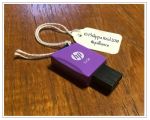 My book – a comprehensive practical guide to quilling techniques – is now written, and was handed over to the publisher this morning. It will be at least six months before it is published, but the timescale is actually now shorter than I had originally been led to believe, and it looks as though it will be printed in time for the Quilling Guild’s annual Celebration event in 2019. I cannot reveal too much about its contents at this early stage, but can safely say it will be completely different from all the other quilling books currently on the market. In writing it, my aim has been to inspire readers across a very broad potential audience, ranging from general crafters to existing quillers and mixed media artists alike. I learned so much on my path towards attaining Higher Level Accreditation with the Quilling Guild in 2016, and in many ways I see this book as the culmination of that journey. I’m looking forward to seeing the page proofs with bated breath …
My book – a comprehensive practical guide to quilling techniques – is now written, and was handed over to the publisher this morning. It will be at least six months before it is published, but the timescale is actually now shorter than I had originally been led to believe, and it looks as though it will be printed in time for the Quilling Guild’s annual Celebration event in 2019. I cannot reveal too much about its contents at this early stage, but can safely say it will be completely different from all the other quilling books currently on the market. In writing it, my aim has been to inspire readers across a very broad potential audience, ranging from general crafters to existing quillers and mixed media artists alike. I learned so much on my path towards attaining Higher Level Accreditation with the Quilling Guild in 2016, and in many ways I see this book as the culmination of that journey. I’m looking forward to seeing the page proofs with bated breath …
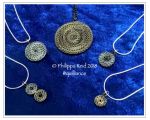 Meanwhile, I am continuing to work closely with my new colleagues at Polkadot to develop an innovative new range of quilled and paper bead jewellery, in which a good deal of customer interest is already being shown. Pieces retained by the gallery from my ‘adoption’ display in the summer are continuing to sell in the run-up to Christmas, and I am gradually replacing them with new styles which particularly feature gold- and silver-effect metallics. I am learning more about different types and lengths of chains, the importance of using Sterling Silver rather than plated findings and the styles that appeal to customers in the context of an upmarket contemporary jewellery environment. Exciting times indeed!
Meanwhile, I am continuing to work closely with my new colleagues at Polkadot to develop an innovative new range of quilled and paper bead jewellery, in which a good deal of customer interest is already being shown. Pieces retained by the gallery from my ‘adoption’ display in the summer are continuing to sell in the run-up to Christmas, and I am gradually replacing them with new styles which particularly feature gold- and silver-effect metallics. I am learning more about different types and lengths of chains, the importance of using Sterling Silver rather than plated findings and the styles that appeal to customers in the context of an upmarket contemporary jewellery environment. Exciting times indeed!
Meanwhile, demand for my conical bead earrings and necklaces made from recycled magazine pages continues undiminished amongst friends, acquaintances and customers at my occasional public workshop events. I am even exploring making beads from marbled paper, old maps and artists’ reject monoprints, too, which fuels the insatiable attraction I feel towards colourful papers. Unwanted scraps of paper which are headed for the bin often have the potential to make fabulous beads!
So ends 2018, with the promise of lots more creative activity in the year ahead. To be honest, I simply cannot wait for it to start!
 So Autumn has arrived at last … and after another wonderful Summer of quilling-related events, it’s time for me to settle down to some quiet productivity once again. Over the next three months, I plan to finish work on my book – a comprehensive, practical guide to quilling techniques which I have been commissioned by a publisher to write. If everything goes according to plan, the book should be printed and available for purchase in the closing months of 2019. It’s an exciting prospect. So, too, is the opportunity that has recently arisen for me to market my quilled jewellery through a high-profile contemporary jewellery gallery. Both these activities look set to shape the path my life will take in the months to come.
So Autumn has arrived at last … and after another wonderful Summer of quilling-related events, it’s time for me to settle down to some quiet productivity once again. Over the next three months, I plan to finish work on my book – a comprehensive, practical guide to quilling techniques which I have been commissioned by a publisher to write. If everything goes according to plan, the book should be printed and available for purchase in the closing months of 2019. It’s an exciting prospect. So, too, is the opportunity that has recently arisen for me to market my quilled jewellery through a high-profile contemporary jewellery gallery. Both these activities look set to shape the path my life will take in the months to come.
If you follow my blog, you may recall that back in the Summer I was ‘adopted’ as an artist by the Polkadot Gallery in Taunton, Somerset, as part of this year’s Taunton Live Arts Festival. This amazing opportunity allowed me to showcase a specially-created collection of quilled and paper bead jewellery in the gallery’s shop window throughout the month of July, and during that period I was successful in achieving several sales. At the end of the month, I was delighted to be invited by the gallery owner to leave my remaining pieces there so that they could officially be taken into stock! Not only that, I was asked to make more and also to supply further items to Polkadot’s main gallery in Exeter, Devon.
One of the great benefits of working with the Polkadot team is the guidance they have given me in terms of developing jewellery styles which reflect current trends and are therefore most likely to sell. In particular, they have encouraged me to focus on developing cone-shaped beads which incorporate spiralling text within the design, alongside an unusual range of quilled solid coil and ring coil pieces which make innovative use of colour and metallic finishes. Sterling Silver chains and fittings also play an important part.
My cabinet at Polkadot’s Taunton gallery now contains the fruits of this collaboration, and I will be delivering further newly-developed stock to Exeter during October.
Development of the conical beads has involved me in a great deal of experimentation, as it certainly is not easy to get text correctly distributed and spaced when you roll and expand the paper being used. Trial and error played a big role in the special promotional beads that Polkadot asked me to try and produce, but the successful result of this work can now be seen in the earrings pictured at the top of this post. I am particularly proud of them!
For the past four years, I have been making quilled competition entries for the fabulous Taunton Flower Show which takes place during the first weekend of August in Taunton, Somerset, UK. The competitions marquee at this major event is huge, with classes ranging from high level floral displays (assessed by judges from the Royal Horticultural Society) to arts, crafts, photography, baking and even giant vegetables!
I always find it a real buzz to take part, and over the years have managed to gain Second and Third Prizes for various entries plus a Highly Commended award … but a First Prize always eluded me – until 2018!
This year, I entered the class for ‘A hand made greeting card for a special birthday’ which required every element to have been created by hand, with no commercial/kit components. You can imagine my delight on entering the marquee after the judging had been completed, to find a ‘First Prize’ sticker beside my entry! Here it is:
For those who like to read about techniques used, here is the text of the notes which I submitted to accompany my entry:
“Two squares of purple card have been cut by hand and matted. The lattice border was created by crimping narrow strips of bronze-edged paper and gluing the peaks of the crimps together. The numerals 6 and 0 were drawn on white paper and cut out by hand, then distressed with gold ink. The oval decorations were created from tightly-rolled strips of coloured paper, which have been wrapped around with gold-edged paper. The flowers at the four corners were made in a similar way. Lengths of gilt-coloured 0.8mm jewellery wire were coiled at each end using round-headed pliers and hammered flat in the centre. The inside sentiment was handwritten, and the filigree decorations made by hand using paper quilling techniques. The gift box for this card was measured and cut by hand.”
I have been enjoying experimenting with jewellery wire this year, after discovering that it can be manipulated into spirals reminiscent of those we use in quilling. It’s a VERY different process from working with paper, however, requiring the use of pliers and a not inconsiderable amount of manual strength, but I believe it complements paper filigree creatively in very interesting ways. Regular readers might recall that I also used wirework in this piece which was displayed recently at the Taunton Live Arts Festival and has been much admired:
As a postscript to my previous account of the Festival, I’m delighted to say that I have now sold two of my framed pictures plus several pieces of the quilled/paper bead jewellery that I have had on display in the prestigious Polkadot Jewellery Gallery in Taunton. So, once again, it’s been a truly fabulous summer in Taunton … and I have a sneaking suspicion that the best is yet to come!!
… so said a sign alongside the Artists’ Quarter at the Big Saturday event of the Taunton Live Arts Festival 2018, where I was privileged to be able to stage a drop-in quilling workshop for a steady stream of keen participants.
I was kept busy all day long helping children and adults alike learn the basics of quilling, alongside a talented ‘free range’ creative team of painters, print-makers, glass fusers and a sculptor.
It was great, and my most cherished moment occurred when I witnessed a young girl successfully explaining the quilling process to her brother using EXACTLY the same steps that I had taught her earlier!
Here are some pictures of the event, kindly shared with me by fellow creatives Mark Adkins, Anthony White and Adam Grose:
I’m delighted to say that my ‘Adopt An Artist’ placements at the Festival have been a great success too. My new ‘Insignia’ series of quilled collage pictures have been well received in St Mary Magdalene church, while my quilled jewellery has actually been selling well in Taunton’s Polkadot Jewellery Gallery.
The opportunities that Taunton Live has brought me are absolutely fantastic, and I am so grateful to the organisers Jenny Keogh and Liz Hutchin for enabling me to get involved.